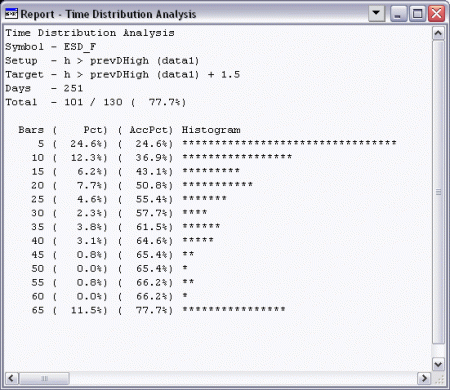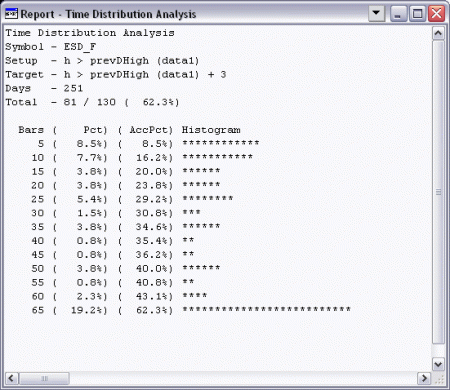An Introduction to Time Distribution Analysis
Knowing just your odds with a particular trading setup may not be enough. You need to know the various possible scenarios that may unfold so that you are ready to handle them. Here is a tool that helps you study your trading setups using time distribution analysis.
Time Distribution Analysis
Time Distribution Analysis is the study of time series behaviour given certain pre-conditions and restrictions. It is different from the more common profile analysis approach which focus on price distributions partitioned by time.
By studying the distributions of the various possible outcomes, we will be able to tell if consequential relationships exist among the pre-conditions and outcomes.
It all sounds very complicated, but believe me, it is just an exercise of exploring the data. Once you have seen an example, you will understand what it means and it will become a very valuable tool in your study of the markets.
Our Tool
Since there is no pre-built tool set available within NeoTicker that can conduct time distribution analysis, we have to create our own. I choose to create an indicator for this task, because it is easier to maintain the tool and add more features to the tool over time.
(You can download the indicator Time Distribution Analysis IDL at the end of this article into your NeoTicker.)
Using the Indicator
You need a chart to apply the indicator. You will also need a report window opened.
My example chart is an emini S&P chart in 1-minute resolution, covering the year 2005.
I have chosen an extremely common pre-condition, namely, the test of previous day high. We will then study the time distributions of various outcomes since the pre-condition is satisfied.
When you apply the indicator onto a chart, here is how it looks like.
I will go over each parameters one by one.
Setup Condition – A formula boolean expression that describe your pre-condition. The formula I have there will show you the time distribution based on the breakout of the previous day high.
Target Condition – A formula boolean expression that describe your expected outcome. In the screenshot, it is showing the formula for the possible outcome of the breakout to make 3 points higher than the previous day high.
Intraday Only – This parameter is necessary if you are analyzing non-intraday only events. In our example, it is indeed an intraday event, thus we will leave this parameter with the default value of Y.
Max Slots – The number of slots we are going to use for the time distribution. When combined with the next parameter, they control the range of time that we are covering within the distribution.
Bars Per Slot – Since we are charting 1-min bars, then at 5 bars per slot, we will have complete distribution information within the first hour after the setup condition is met.
Report Window – If this parameter is left blank, then our analysis report will be sent to the first available report window. If you have never opened a report window, you probably wonder what they are and why they exist at all. Report windows are there so that you can generate customized data output easily. This article is giving you a good reason to use this type of function window.
First Look at the Distribution
Here is our first analysis result, based on the outcome of breaking out at least 1.5 points over the previous day high. The answer we are looking for, is the amount of time it will take to meet this target condition.
Lets walk-thru the basic information provided in this report. The obvious ones are the symbol, setup and target. They are simply the input to the indicator.
The Days item is telling you the number of days the indicator has analyzed.
The Total item is telling you the number of times the target criteria is fulfilled and the number of times the setup criteria is fulfilled. The percent displayed to the right is simply the ratio between the 2 numbers.
The histogram below the summary section is the one that we are interested in.
Take a look at the first line of the histogram – it is telling us that within the first 5 bars, or, the first 5 minutes, the market historically exceed the previous day high by 1.5 points. It happened 24% out of the total 77% that this criteria has happened. Thats very significant because now we know, if history repeats itself frequent enough, we can jump on board to a previous day high breakout, with a very strong likelihood that the market will go higher 1.5 points within the first 5 minutes.
If you look closely, the rest of the histogram is telling us that within the first 45 minutes after the previous day high being taken out, it is likely we will reach 1.5 points higher than the previous day high, even if it has not done so in the first 5 minutes. This alone is giving us a good setup to trade with if we have good execution speed.
Hoping for More
What about making 3 points instead of just 1.5 points?
Here is the distribution.
It is obvious that the probability that we can make 3 points higher than the previous day high within the first 45 minutes of the break out, is a lot less likely than just 1.5 points. The distribution gives us a sweet spot to hang onto our break out position once we took some profit at the 1.5 points mark – thats 30 minutes from the time of breakout.
Understand the Risk
After taking care of the profit potential, lets take a look into the risk factor.
Here is the distribution based on the outcome of price reaching 2 points below the previous day high.
This distribution confirms the strength of the emini S&P within the first 5 to 10 minutes after breaking out of the previous day high. The combined probability of going lower for 2 points within the first 30 minutes is also very limited.
One fact could be surprising to many – the most probable time that a drop of 2 points or more from the previous day high is an hour after the break out.
A Better Plan
Combining all the information we have collected from the time distributions, we can now formulate a more complete strategy –
1. If we are bullish, then we should jump on board as soon as possible when the breakout of the previous day high has happened. Then we can piece out our position at the 1.5 point mark while waiting to see if the 3 point mark can be broken. If 30 minutes has passed and no signs of improvement, then we should consider bail out as soon as possible.
2. If we are bearish, then remember the combined odds of the market dropping 2 points is pretty much a 50/50 scenario, in a simple test of previous day high scenario. It is then important to have other filtering condition to confirm the bearish scenario before you take the setup.
3. The bullish edge behind the breakout setup is very limited, judging from the drop in odds from the 1.5 point mark to the 3 point one. Thus when we trade this setup, we should not chase the market, no matter we are bullish or bearish.
Complete Indicator
Script version Time Distribution Analysis.
Summary
Most traders focus simply on the odds – a simple number on their setup whether it is highly profitable or not. That does not tell the complete story behind the trading setup at all. If we expect to trade proficiently, then it is better we understand our trading setups with more depth.
Take the time to try out various combinations of your favourite trading setups to see how their time distributions look like. I am sure you will discover something useful.

















